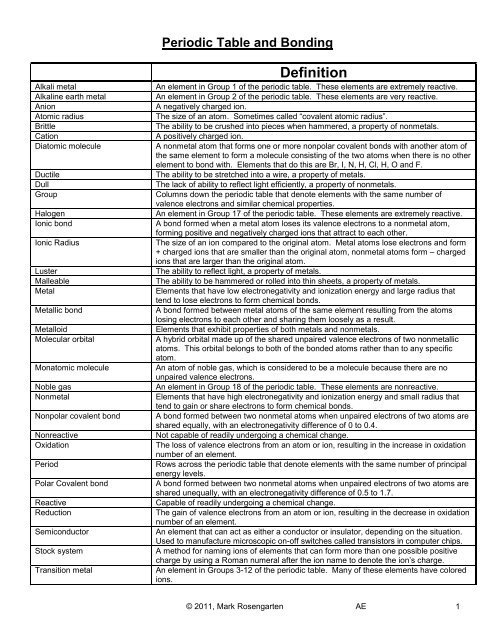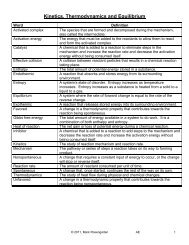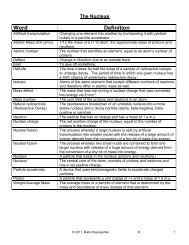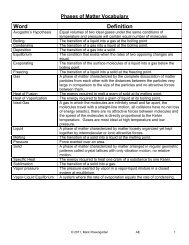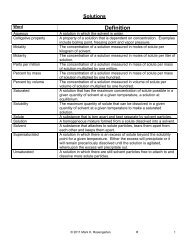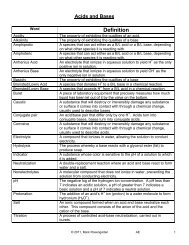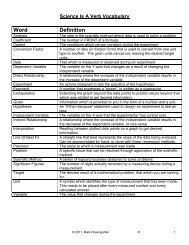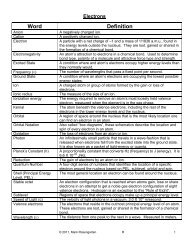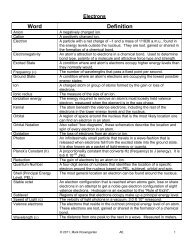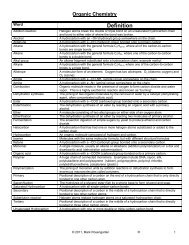Unit 6: Periodic Table and Bonding - Mark Rosengarten
Unit 6: Periodic Table and Bonding - Mark Rosengarten
Unit 6: Periodic Table and Bonding - Mark Rosengarten
You also want an ePaper? Increase the reach of your titles
YUMPU automatically turns print PDFs into web optimized ePapers that Google loves.
<strong>Periodic</strong> <strong>Table</strong> <strong>and</strong> <strong>Bonding</strong><br />
Word<br />
Alkali metal<br />
Alkaline earth metal<br />
Anion<br />
Atomic radius<br />
Brittle<br />
Cation<br />
Diatomic molecule<br />
Ductile<br />
Dull<br />
Group<br />
Halogen<br />
Ionic bond<br />
Ionic Radius<br />
Luster<br />
Malleable<br />
Metal<br />
Metallic bond<br />
Metalloid<br />
Molecular orbital<br />
Monatomic molecule<br />
Noble gas<br />
Nonmetal<br />
Nonpolar covalent bond<br />
Nonreactive<br />
Oxidation<br />
Period<br />
Polar Covalent bond<br />
Reactive<br />
Reduction<br />
Semiconductor<br />
Stock system<br />
Transition metal<br />
Definition<br />
An element in Group 1 of the periodic table. These elements are extremely reactive.<br />
An element in Group 2 of the periodic table. These elements are very reactive.<br />
A negatively charged ion.<br />
The size of an atom. Sometimes called “covalent atomic radius”.<br />
The ability to be crushed into pieces when hammered, a property of nonmetals.<br />
A positively charged ion.<br />
A nonmetal atom that forms one or more nonpolar covalent bonds with another atom of<br />
the same element to form a molecule consisting of the two atoms when there is no other<br />
element to bond with. Elements that do this are Br, I, N, H, Cl, H, O <strong>and</strong> F.<br />
The ability to be stretched into a wire, a property of metals.<br />
The lack of ability to reflect light efficiently, a property of nonmetals.<br />
Columns down the periodic table that denote elements with the same number of<br />
valence electrons <strong>and</strong> similar chemical properties.<br />
An element in Group 17 of the periodic table. These elements are extremely reactive.<br />
A bond formed when a metal atom loses its valence electrons to a nonmetal atom,<br />
forming positive <strong>and</strong> negatively charged ions that attract to each other.<br />
The size of an ion compared to the original atom. Metal atoms lose electrons <strong>and</strong> form<br />
+ charged ions that are smaller than the original atom, nonmetal atoms form – charged<br />
ions that are larger than the original atom.<br />
The ability to reflect light, a property of metals.<br />
The ability to be hammered or rolled into thin sheets, a property of metals.<br />
Elements that have low electronegativity <strong>and</strong> ionization energy <strong>and</strong> large radius that<br />
tend to lose electrons to form chemical bonds.<br />
A bond formed between metal atoms of the same element resulting from the atoms<br />
losing electrons to each other <strong>and</strong> sharing them loosely as a result.<br />
Elements that exhibit properties of both metals <strong>and</strong> nonmetals.<br />
A hybrid orbital made up of the shared unpaired valence electrons of two nonmetallic<br />
atoms. This orbital belongs to both of the bonded atoms rather than to any specific<br />
atom.<br />
An atom of noble gas, which is considered to be a molecule because there are no<br />
unpaired valence electrons.<br />
An element in Group 18 of the periodic table. These elements are nonreactive.<br />
Elements that have high electronegativity <strong>and</strong> ionization energy <strong>and</strong> small radius that<br />
tend to gain or share electrons to form chemical bonds.<br />
A bond formed between two nonmetal atoms when unpaired electrons of two atoms are<br />
shared equally, with an electronegativity difference of 0 to 0.4.<br />
Not capable of readily undergoing a chemical change.<br />
The loss of valence electrons from an atom or ion, resulting in the increase in oxidation<br />
number of an element.<br />
Rows across the periodic table that denote elements with the same number of principal<br />
energy levels.<br />
A bond formed between two nonmetal atoms when unpaired electrons of two atoms are<br />
shared unequally, with an electronegativity difference of 0.5 to 1.7.<br />
Capable of readily undergoing a chemical change.<br />
The gain of valence electrons from an atom or ion, resulting in the decrease in oxidation<br />
number of an element.<br />
An element that can act as either a conductor or insulator, depending on the situation.<br />
Used to manufacture microscopic on-off switches called transistors in computer chips.<br />
A method for naming ions of elements that can form more than one possible positive<br />
charge by using a Roman numeral after the ion name to denote the ion’s charge.<br />
An element in Groups 3-12 of the periodic table. Many of these elements have colored<br />
ions.<br />
© 2011, <strong>Mark</strong> <strong>Rosengarten</strong> AE 1
The Elements - written by Tom Lehrer, 1959<br />
Antimony (Sb) Indium (In) Hafnium (Hf) Cadmium (Cd)<br />
Arsenic (As) Gallium (Ga) Erbium (Er) Calcium (Ca)<br />
Aluminum (Al) Iodine (I) Phosphorous (P) Chromium (Cr)<br />
Selenium (Se) Thorium (Th) Francium (Fr) Curium (Cm)<br />
Hydrogen (H) Thulium (Tm) Fluorine (F) Sulfur (S)<br />
Oxygen (O) Thallium (Tl) Terbium (Tb) Californium (Cf)<br />
Nitrogen (N) Yttrium (Y) Manganese (Mn) Fermium (Fm)<br />
Rhenium (Re) Ytterbium (Yb) Mercury (Hg) Berkelium (Bk)<br />
Nickel (Ni) Actinium (Ac) Molybdenum (Mo) Mendelevium (Md)<br />
Neodymium (Nd) Rubidium (Rb) Magnesium (Mg) Einsteinium (Es)<br />
Neptunium (Np) Boron (B) Dysprosium (Dy) Nobelium (No)<br />
Germanium (Ge) Gadolinium (Gd) Sc<strong>and</strong>ium Sc) Argon (Ar)<br />
Iron (Fe) Niobium (Nb) Cerium (Ce) Krypton (Kr)<br />
Americium (Am) Iridium (Ir) Cesium (Cs) Neon (Ne)<br />
Ruthenium (Ru) Strontium (Sr) Lead (Pb) Radon (Rn)<br />
Uranium (U) Silicon (Si) Praeseodymium (Pr) Xenon (Xe)<br />
Europium (Eu) Silver (Ag) Platinum (Pt) Zinc (Zn)<br />
Zirconium (Zr) Samarium (Sm) Plutonium (Pu) Rhodium (Rh)<br />
Lutetium (Lu) Bismuth (Bi) Palladium (Pd) Chlorine (Cl)<br />
Vanadium (V) Bromine (Br) Promethium (Pm) Carbon (C)<br />
Lanthanum (La) Lithium (Li) Potassium (K) Cobalt (Co)<br />
Osmium (Os) Beryllium (Be) Polonium (Po) Copper (Cu)<br />
Astatine (At) Barium (Ba) Tantalum (Ta) Tungsten (W)<br />
Radium (Ra) Holmium (Ho) Technetium (Tc) Tin (Sn)<br />
Gold (Au) Helium (He) Titanium (Ti) Sodium (Na)<br />
Protactinium (Pa)<br />
Tellurium (Te)<br />
* as of this date, add Lawrencium (Lr), Rutherfordium (Rf), Dubnium (Db), Seaborgium (Sg), Bohrium, (Bh), Hassium<br />
(Hs), Meitnerium (Mt), Darmstadtium (Ds), Copernicum (Cp), Roentgenium (Rg) <strong>and</strong> a couple of other as of yet<br />
unnamed elements.<br />
© 2011, <strong>Mark</strong> <strong>Rosengarten</strong> AE 2
1) The <strong>Periodic</strong> <strong>Table</strong> (HW: p. 15-21)<br />
Essential Question: How did the structure of the atom influence the design of the <strong>Periodic</strong> <strong>Table</strong>?<br />
Groups<br />
1 2 3 4 5 6 7 8 9 10 11 12 13 14 15 16 17 18<br />
1 H He<br />
2 Li Be B C N O F Ne<br />
3 Na Mg Al Si P S Cl Ar<br />
4 K Ca Sc Ti V Cr Mn Fe Co Ni Cu Zn Ga Ge As Se Br Kr<br />
5 Rb Sr Y Zr Nb Mo Tc Ru Rh Pd Ag Cd In Sn Sb Te I Xe<br />
6 Cs Ba La-<br />
Lu<br />
7 Fr Ra Ac-<br />
Lr<br />
Hf Ta W Re Os Ir Pt Au Hg Tl Pb Bi Po At Rn<br />
Rf Ha Sg Bh Hs Mt Ds Cp Rg<br />
A) Development of the <strong>Periodic</strong> <strong>Table</strong><br />
The <strong>Periodic</strong> <strong>Table</strong> was developed by Dmitri Mendeleev <strong>and</strong> Lothar Meyer in 1869.<br />
The Modern <strong>Periodic</strong> Law<br />
The properties of elements are periodic functions or their atomic numbers.<br />
HUH?<br />
As atomic number increases, certain properties, like number of valence electrons, ionization energy <strong>and</strong> ion charge<br />
repeat periodically. <strong>Periodic</strong>ally? Yes, it means “at certain intervals”. This is why it’s called a PERIODIC table!<br />
Elements are ordered in rows called PERIODS <strong>and</strong> columns called GROUPS.<br />
Direction Importance Examples<br />
PERIODS All elements in the same period have the Na, Mg, Al, Si, P, S, Cl <strong>and</strong> Ar are all in Period 3. They all<br />
(rows) same number of principal energy levels have three PEL’s in their atomic structure.<br />
GROUPS<br />
(columns)<br />
in their atomic structure<br />
All elements in the same group have the<br />
same number of valence electrons,<br />
therefore lose or gain the same number<br />
of electrons, form similar chemical<br />
formulas <strong>and</strong> have similar chemical<br />
properties<br />
Li, Na, K, Rb, Cs <strong>and</strong> Fr are all in Group 1. They all have<br />
one valence electron, they all lose one electron when forming<br />
+1 ions, <strong>and</strong> they are all extremely reactive. They have<br />
similar chemical properties <strong>and</strong> form the following formulas<br />
when bonding to oxygen: Li 2 O, Na 2 O, K 2 O, Rb 2 O, Cs 2 O <strong>and</strong><br />
Fr 2 O.<br />
B) Sizes Of Atoms<br />
Atomic radius - 1/2 the measured distance between two nuclei of the element in the solid phase.<br />
a) Within a period of the table, the radius generally decreases as the atomic number<br />
increases. This is due to an increase in nuclear charge as the atomic number increases,<br />
causing an increase in attraction between the nucleus <strong>and</strong> the valence electrons, pulling them<br />
closer together.<br />
Example: In Period 3, the all of the valence electrons are in the same energy level (3). As<br />
the atomic number increases, the number of protons increases. Na has 11 protons, Mg has<br />
12, Al 13, Si 14, <strong>and</strong> so on. As the number of positive protons increases, the attraction<br />
between the electrons <strong>and</strong> the nucleus increases, making each successive<br />
atom smaller than the previous one.<br />
© 2011, <strong>Mark</strong> <strong>Rosengarten</strong> AE 3
) Within a group of the table, the radius increases as the atomic number increases. This is due to an additional<br />
PEL between the nucleus <strong>and</strong> the valence PEL, increasing the distance between the valence PEL <strong>and</strong> the nucleus.<br />
The more layers an onion has, the larger the onion is. Therefore, K is larger than Na because K has 4 energy levels,<br />
<strong>and</strong> Na only has 3.<br />
C) Element Types<br />
Elements on the <strong>Periodic</strong> <strong>Table</strong> are divided into three subgroups called metals, nonmetals <strong>and</strong> metalloids<br />
(semimetals). Here is the breakdown:<br />
Groups<br />
1 2 3 4 5 6 7 8 9 10 11 12 13 14 15 16 17 18<br />
1 H He<br />
2 Li Be B C N O F Ne<br />
3 Na Mg Al Si P S Cl Ar<br />
4 K Ca Sc Ti V Cr Mn Fe Co Ni Cu Zn Ga Ge As Se Br Kr<br />
5 Rb Sr Y Zr Nb Mo Tc Ru Rh Pd Ag Cd In Sn Sb Te I Xe<br />
6 Cs Ba La-<br />
Lu<br />
7 Fr Ra Ac-<br />
Lr<br />
Hf Ta W Re Os Ir Pt Au Hg Tl Pb Bi Po At Rn<br />
Rf Ha Sg Bh Hs Mt Ds Cp Rg<br />
Key:<br />
Ba metal B Metalloid Cl Nonmetal<br />
These elements have distinctive properties that give them identities.<br />
D) Properties of Atoms on the <strong>Periodic</strong> <strong>Table</strong><br />
Electronegativity: an atom's attraction for electrons in a chemical bond. Elements with small atomic radius have<br />
a greater attraction for electrons, <strong>and</strong> therefore have a higher electronegativity. It is measured on a relative scale, with<br />
fluorine having the highest electronegativity (4.0). Electronegativity can be found on Reference <strong>Table</strong> S.<br />
First Ionization Energy: the energy required to remove the most loosely held valence electron from the atom<br />
to form a positive ion when the atom is in the gas phase. This is directly proportional to the electronegativity,<br />
because the more tightly an atom is attracted to is electrons, the more energy it is going to require to remove that<br />
electron.<br />
In general, metals have low electronegativities <strong>and</strong> ionization energies, <strong>and</strong> tend to lose their valence electrons to form<br />
+ ions when bonding to nonmetal atoms. Nonmetal atoms have high electronegativities <strong>and</strong> ionization energies, <strong>and</strong><br />
gain electrons from metal atoms to form - ions, or bond with other nonmetals to form covalent bonds.<br />
Metallic Character: the degree to which an element matches the characteristics of metals. Metals lose<br />
electrons <strong>and</strong> form + ions, therefore elements that have low electronegativity <strong>and</strong> lose electrons easily have high<br />
metallic character.<br />
Nonmetallic Character: the degree to which an element matches the characteristics of nonmetals. Nonmetals<br />
gain electrons <strong>and</strong> form - ions, therefore elements which have high electronegativity <strong>and</strong> gain electrons easily have<br />
high nonmetallic character.<br />
© 2011, <strong>Mark</strong> <strong>Rosengarten</strong> AE 4
E) Chemistry Of Metals, Nonmetals <strong>and</strong> Metalloids<br />
Type EN &<br />
IE<br />
Radius What they do<br />
with electrons<br />
Metals Low Large Lose<br />
(ionic bonding)<br />
Nonmetals High Small Gain<br />
(ionic bond)<br />
Ion Properties<br />
Charge<br />
Positive • Excellent conductors of heat <strong>and</strong> electricity<br />
• Malleable (can be hammered or rolled into thin<br />
sheets) <strong>and</strong> Ductile (can be drawn into a wire)<br />
• Shiny (has luster)<br />
• Make up more than 2/3 of the elements<br />
• Metallic character increases as ionization energy<br />
decreases. Fr is the most metallic element on the<br />
<strong>Periodic</strong> <strong>Table</strong>.<br />
Negative • Poor conductors of heat <strong>and</strong> electricity<br />
• Brittle (shatters when struck)<br />
• Dull appearance, not shiny like metals<br />
Share<br />
(covalent bond)<br />
Metalloids Med. Med. Usually share Either • Semiconductors (sometimes they conduct,<br />
sometimes they don’t)<br />
• Used for making computer microchips<br />
• Luster (like metals) <strong>and</strong> Brittle (like nommetals)<br />
F) Ions<br />
For every electron an atom gains, it becomes more negatively charged. If an atom gains three electrons when<br />
forming a bond, the atom becomes a -3 ion. If an atom loses two electrons when forming a bond, it becomes a -2 ion.<br />
When an atom becomes an ion, it does so by gaining or losing in such a way that it ends up with 8<br />
valence electrons (called a stable octet). The electrons are gained or lost from the valence s <strong>and</strong> p sublevels. If an<br />
element has 1-3 valence electrons, it will opt to lose them. Here is an example of an atom that does this:<br />
Sodium (Na): 2-8-1 Sodium has 1 valence electron. It can either gain 7 (to form the configuration 2-8-8 ) or lose 1<br />
(to form the configuration 2-8). Either way, it ends up with 8 valence electrons. Nature tends to do things that take<br />
less energy, <strong>and</strong> the second option...that of losing the electrons...is what sodium does.<br />
If the atom has from 5 to 7 valence electrons, it will opt to gain electrons, forming negative ions. For example: chlorine<br />
(2-8-7) has seven valence electrons, so it is no trick at all for it to just gain the one more that it needs to form a -1 ions<br />
<strong>and</strong> have its stable octet (2-8-8)<br />
Group<br />
Valence Electron<br />
Configuration<br />
# Valence<br />
Electrons<br />
How it forms an ion<br />
Charge<br />
of ion<br />
Ion Valence<br />
Electron<br />
Configuration<br />
1 -1 1 loses 1 +1 -8<br />
2 -2 2 loses 2 +2 -8<br />
13 -3 3 loses 3 +3 -8<br />
14 -4 4 loses 4 (to a more +4 -8<br />
electronegative atom)<br />
gains 4 (from a less<br />
electronegative atom) -4<br />
15 -5 5 gains 3 -3 -8<br />
16 -6 6 gains 2 -2 -8<br />
17 -7 7 gains 1 -1 -8<br />
18 -8 8 doesn't need to 0 -8<br />
Note: Elements in the middle can lose electrons from both the valence energy level <strong>and</strong> the one below it when forming<br />
ions. This allows for a wide range of ion charges. Some of these elements can form more than one possible charge.<br />
For example, Cu can form charges of +1 or +2, <strong>and</strong> Fe can form charges of +2 or +3 depending on the circumstances<br />
of the reaction.<br />
© 2011, <strong>Mark</strong> <strong>Rosengarten</strong> AE 5
When an atom gains electrons, its radius increases. When an atom loses electrons, its radius decreases.<br />
Na (2-8-1) loses its one valence electron.<br />
Its new electron configuration is 2-8. It<br />
now only has two PEL’s instead of three.<br />
Na +1 has a smaller radius than Na 0 had,<br />
because an energy level is lost.<br />
Metal ions have a smaller radius than<br />
metal atoms.<br />
Cl (2-8-7) gains one electron to make a<br />
stable octet. The one additional electron<br />
makes Cl -1 (2-8-8) bigger than Cl 0<br />
because the extra electron increases the<br />
repulsion between the electrons in the<br />
valence shell.<br />
Nonmetal ions have a larger radius than<br />
nonmetal atoms.<br />
G) Naming Elements<br />
The names of the elements are provided for you in the back of your textbook. For the most part, the symbols<br />
reflect the names. The exceptions to this are the elements that have roots in antiquity, so they had Greek or Latin<br />
names. These are the elements that have been known since antiquity. Here is a listing of those elements:<br />
Element Symbol Traditional Name Element Symbol Traditional Name<br />
Antimony Sb Stibnum (from Stibnite ore) Potassium K Kalium<br />
Iron Fe Ferrum Copper Cu Cuprum ("from Cyprus")<br />
Gold Au Aurum ("shining dawn") Tungsten W Wolfram ("heavy stone")<br />
Silver Ag Argentum Tin Sn Stannum<br />
Mercury Hg Hydrargyrum ("liquid silver") Sodium Na Natrium<br />
Lead Pb Plumbium<br />
H) Naming Ions<br />
The names of ions are dependent on the charge of the ion in question.<br />
Positive ions retain the name of the element. If the atom is capable of forming more than one possible<br />
ion (like Fe can form charges of +2 or +3...these are indicated as Oxidation States in the upper right corner of<br />
each element box on the <strong>Periodic</strong> <strong>Table</strong>), then a Roman numeral is placed after the ion name, signifying the<br />
charge.<br />
Examples:<br />
Elements with One Charge<br />
Elements with more than One Possible Charge<br />
Ion Name Ion Name Ion Name<br />
Na +1 sodium Fe +2 iron (II) Pb +2 lead (II)<br />
K +1 potassium Fe +3 iron (III) Pb +4 lead (IV)<br />
Ca +2 calcium Cu +1 copper (I) Cr +2 chromium (II)<br />
Mg +2 magnesium Cu +2 copper (II) Cr +3 chromium (III)<br />
Ag +1 silver Au +1 gold (I) Sn +2 tin (II)<br />
Al +3 aluminum Au +3 gold (III) Sn +4 tin (IV)<br />
Using Roman numerals to identify the ion charge is called the Stock system.<br />
© 2011, <strong>Mark</strong> <strong>Rosengarten</strong> AE 6
Negative ions are named after the element, with the second syllable replaced with the suffix -ide. For<br />
example:<br />
Ion Element Name Ion Name Ion Element Name Ion Name<br />
O -2 oxygen Oxide S -2 Sulfur sulfide<br />
N -3 nitrogen Nitride P -3 Phosphorous phosphide<br />
H -1 hydrogen Hydride Cl -1 Chlorine chloride<br />
I) Chemistry of The Groups of the <strong>Periodic</strong> <strong>Table</strong><br />
As we have already seen, the groups on the <strong>Periodic</strong> <strong>Table</strong> are broken into groups of similar chemical<br />
properties. The following table shows the breakdown, <strong>and</strong> the names of the various groups. A description of the<br />
properties of the elements will follow.<br />
Groups<br />
1 2 3 4 5 6 7 8 9 10 11 12 13 14 15 16 17 18<br />
1 H He<br />
2 Li Be B C N O F Ne<br />
3 Na Mg Al Si P S Cl Ar<br />
4 K Ca Sc Ti V Cr Mn Fe Co Ni Cu Zn Ga Ge As Se Br Kr<br />
5 Rb Sr Y Zr Nb Mo Tc Ru Rh Pd Ag Cd In Sn Sb Te I Xe<br />
6 Cs Ba La-<br />
Lu<br />
7 Fr Ra Ac-<br />
Lr<br />
Hf Ta W Re Os Ir Pt Au Hg Tl Pb Bi Po At Rn<br />
Rf Ha Sg Bh Hs Mt Ds Cp Rg<br />
G.1 alkali<br />
metals<br />
G.2 alkaline<br />
earth metals<br />
G.<br />
3-12<br />
Transition<br />
elements<br />
G.<br />
17<br />
halogens G.<br />
18<br />
noble<br />
gases<br />
Group Name # Val. e- Ion Charge Notes<br />
1 Alkali Metals 1 +1 • Extremely reactive, only found in compounds<br />
• Can be extracted from compounds using electricity<br />
• Reacts violently with water to form H 2 (g) <strong>and</strong> a base<br />
• Alkali means base (as opposed to acid)<br />
2 Alkaline Earth<br />
Metals<br />
3-12 Transition<br />
Metals<br />
2 +2 • Very reactive, only found in compounds<br />
• Can be extracted from compounds using chemical reactions<br />
• Reacts quickly with water for form H 2 (g) <strong>and</strong> a base<br />
• Alkaline means base<br />
varies +1 to +7 • Range of reactivities, some are quite reactive, others are<br />
nonreactive.<br />
• Some can be found in pure form in nature (Cu, Ag, Au)<br />
• Ions are colored, so compounds with transition elements in<br />
them are often colored.<br />
• Many form multiple charges, need the Stock system to<br />
name those that do<br />
17 Halogens 7 -1 • Extremely reactive <strong>and</strong> corrosive, only found in compounds<br />
• Can be extracted from compounds using electricity<br />
• Reacts violently with metals for form halide compounds (like<br />
NaCl)<br />
18 Noble Gases 8 0 • Completely nonreactive, never found in compounds<br />
• Xe <strong>and</strong> Kr can be forced to react with F 2 in the lab<br />
• They have a stable octet, so they don’t need to bond<br />
© 2011, <strong>Mark</strong> <strong>Rosengarten</strong> AE 7
PHASES<br />
All elements are solids at 25 o C except the following:<br />
Liquids - Hg, Br<br />
Gases - N, O, F, Cl, H, He, Ne, Ar, Kr, Xe, Rn<br />
Which of the following elements is a nonmetallic gas at 25 o C?<br />
a) Zn b) Br c) Cl d) Hg<br />
Which of the following elements is a metallic liquid at 25 o C?<br />
a) Zn b) Br c) Cl d) Hg<br />
Allotropes<br />
These different forms arise because of the different conditions that elements may be found.<br />
Examples:<br />
Carbon: coal (amorphous mass), diamond (network bonded crystal), graphite (mineral where the carbon atoms are<br />
bonded in weakly connected sheet structures)<br />
Oxygen: O 2 (diatomic oxygen), O 3 (ozone)<br />
Phosphorous: red, white <strong>and</strong> yellow phosphorous<br />
MOLECULE: a particle made of nonmetals atoms that are covalently bonded together. The number of atoms<br />
of each element is consistent from molecule to molecule (for example, a molecule of water ALWAYS contains<br />
two hydrogen atoms covalently bonded to one oxygen atom).<br />
MONATOMIC MOLECULES: Since the noble gases do not react with other elements, the individual atoms are<br />
considered to be "molecules" of that gas. So, Kr is not just considered to be an atom, but a molecule as well.<br />
He, Ne, Ar, Kr, Xe <strong>and</strong> Rn do not bond to other elements, so an atom of each of these can also be considered a<br />
molecule. A molecule made of one atomMONatomic! Mono, meaning one!<br />
Which of the following elements will form monatomic molecules?<br />
a) Zn b) Na c) Ne d) N<br />
DIATOMIC MOLECULES: Certain elements are found free <strong>and</strong> uncombined in nature, but are reactive. To become<br />
stable, they react with themselves, <strong>and</strong> are found as diatomic molecules, two atoms of the element bonded to each<br />
other. These elements are:<br />
Br 2 , I 2 , N 2 , Cl 2 , H 2 , O 2 , F 2<br />
Br I N Cl H O F<br />
When these elements are free <strong>and</strong> uncombined with other elements, they are always found in their diatomic state. For<br />
example, H + H H 2 , H 2 is more stable than H. These can also be thought of as the “Twinkie Molecules”, because<br />
they are always found in a two-pack.<br />
Example: Zn + 2 HCl ZnCl 2 + H 2<br />
The H 2 on the right side is diatomic hydrogen, when not bonded to another element, it forms diatomic molecules.<br />
Which of the following elements will form diatomic molecules?<br />
a) Zn b) Na c) Ne d) N<br />
© 2011, <strong>Mark</strong> <strong>Rosengarten</strong> AE 8
2) <strong>Bonding</strong> (HW: p. 22-24)<br />
Essential Question: What makes atoms stick together to form compounds <strong>and</strong> molecules?<br />
Chemical bond - results from the competition for valence electrons between two atoms. Chemical bonds are<br />
what hold atoms together to make compounds, <strong>and</strong> what are broken when compounds are decomposed back<br />
into the original elements.<br />
IONIC BONDING<br />
1) Occurs between a metal atom <strong>and</strong> a nonmetal atom<br />
2) The nonmetal atom has a higher electronegativity than the metal atom, <strong>and</strong> therefore wins the competition for the<br />
valence electrons. The nonmetal atom gains electrons from the metal atom, which loses all of its valence electrons to<br />
the nonmetal.<br />
3) The number of electrons lost or gained will be the number needed by each atom to form a stable octet (8 valence<br />
electrons)<br />
4) The metal atom loses electrons (oxidation) <strong>and</strong> becomes a + charged cation.<br />
5) The nonmetal atom gains electrons (reduction) <strong>and</strong> becomes a - charged anion.<br />
6) The two oppositely charged ions attract each other. This forms an ionic bond. It is a surface attraction, <strong>and</strong> may be<br />
broken simply by melting or dissolving in water.<br />
To determine for sure if a bond is ionic, look up the electronegativities of the two bonding elements on Reference<br />
<strong>Table</strong> S <strong>and</strong> take their difference. If it is above 1.7 then the atom with the higher electronegativity has enough<br />
pull to remove the electrons from the atom with the lower electronegativity.<br />
How does an ionic bond form between Na <strong>and</strong> Cl?<br />
Element Types? Na: METAL<br />
Cl: NONMETAL<br />
EN of Na = 0.9 EN of Cl = 3.2 END = 2.3 (which is above 1.7, ionic)<br />
1) The Na loses its valence electron (oxidation) <strong>and</strong> becomes Na +1 (a cation).<br />
2) The Cl gains the electron that Na lost (reduction) <strong>and</strong> becomes Cl -1 (an anion)<br />
3) The Na +1 <strong>and</strong> Cl -1 , having opposite charges, attract <strong>and</strong> form an ionic bond (NaCl).<br />
This bond can be broken by melting the NaCl (heating it to its melting point gives the ions enough energy to separate<br />
from each other, like pulling on two magnets that are stuck together). Dissolving the NaCl in water will also break the<br />
bond, causing the NaCl to separate into Na +1 <strong>and</strong> Cl -1 , which cling to the water molecules that dissolved them.<br />
PROPERTIES OF IONIC COMPOUNDS:<br />
1) high melting <strong>and</strong> boiling points (NaCl melts at a temperature of 1074 K, compared to 273 K for water)<br />
2) low vapor pressure (they don’t tend to evaporate, where substances like water evaporate easily)<br />
3) brittle (crushes easily into powder, unlike pure metals, which are malleable)<br />
4) Ionic liquids <strong>and</strong> solutions conduct electricity because the charged particles are free to move around <strong>and</strong> carry their<br />
electrical charge from one place to another. Ionic solutions (like salt water) are called electrolytes, because they can<br />
conduct electricity through them. Electrolytes are used by the body to conduct current through nerves <strong>and</strong> muscles.<br />
5) Ionic solids do not conduct electricity because the ions are held together in the crystal lattice <strong>and</strong> can’t move<br />
around.<br />
© 2011, <strong>Mark</strong> <strong>Rosengarten</strong> AE 9
Ionic Crystal Structure, then adding heat (or dissolving in water) to break up the crystal into a liquid<br />
composed of free-moving ions.<br />
Notice in the SOLID IONIC CRYSTAL, the ions are locked in place, unable to move around. This is why ionic<br />
solids can’t conduct electricity. When the ions are broken up by adding heat or dissolving in water, the ions<br />
are now free. If you place wires connected to a source of electricity (like a battery) into the water, the ions will<br />
carry the electrical charge from one wire to the other wire, allowing the electric current to keep flowing. If you<br />
keep mail carriers locked up inside of a room, they can’t carry mail! If you set them free, they can carry mail<br />
to anywhere they need to.<br />
IONIC BONDING DOT DIAGRAMS<br />
When a metal loses its valence electrons, it now has 0 electrons in what was the valence shell. To write the<br />
dot diagram of the metal ion, write its symbol, put 0 dots around it, put it in brackets <strong>and</strong> write the charge outside the<br />
brackets, on the upper right side.<br />
When a nonmetal gains valence electrons, it now has 8 electrons in the valence shell. To write the dot diagram of the<br />
nonmetal ion, write its symbol, put 8 dots around it, put it in brackets <strong>and</strong> write the charge outside the brackets on the<br />
upper right side.<br />
To draw the dot diagram of the ionic compound, simply put the ion dot diagrams next to each other so that:<br />
1) The ion charges cancel out (add up to zero)<br />
2) The opposite charged ions are next to each other, <strong>and</strong> the like charged ions are as far away from each<br />
other as they can be.<br />
© 2011, <strong>Mark</strong> <strong>Rosengarten</strong> AE 10
Example Ionic <strong>Bonding</strong> Dot Diagrams:<br />
Formula<br />
LiF<br />
Dot Diagram<br />
BeO<br />
Li 2 O<br />
BeF 2<br />
COVALENT BONDING<br />
1) Two NONMETAL atoms attempt to gain each other’s valence electrons. They do not have enough difference in<br />
electronegativity to do so, therefore they share them.<br />
2) The electrons shared are the unpaired valence electrons.<br />
3) The bonded atoms actually become part of each other. This makes for a bond much stronger than an ionic bond.<br />
This bond can not be broken by dissolving in water or melting, so covalent compounds never conduct electricity,<br />
regardless of the phase (exception later this year).<br />
To determine if a bond is covalent, check the electronegativity difference. If it is below 1.7, the atom with the higher<br />
electronegativity does not have enough pull to remove the other atom’s electrons, so they share them. Each bonded<br />
atom has 8 valence electrons after bonding, except for hydrogen (H), which is only large enough to have 2 valence<br />
electrons after bonding (because of H’s single energy level, which can only hold up to 2 electrons.<br />
How many covalent bonds can a nonmetal atom form?<br />
Nonmetal Dot Diagram # unpaired<br />
e-<br />
# of<br />
covalent<br />
bonds<br />
Nonmetal Dot Diagram # unpaired<br />
e-<br />
N<br />
3 3<br />
S<br />
2 2<br />
O<br />
2 2<br />
Cl<br />
1 1<br />
F<br />
1 1<br />
P<br />
3 3<br />
C<br />
4 4<br />
Br<br />
1 1<br />
H<br />
1 1<br />
I<br />
1 1<br />
# of covalent<br />
bonds<br />
Making Molecules: Molecules are particles made from nonmetal atoms covalently bonding together. Each molecule<br />
of a substance has an identical molecular formula that tells you exactly how many atoms of each element are found in<br />
the molecule. H 2 O (water) is a molecule made of two atoms of hydrogen bonded to one oxygen atom. CH 4 (methane<br />
natural gas) is a molecule made of one carbon atom with four hydrogen atoms bonded to it. NH 3 (ammonia) is made<br />
of one atom of nitrogen with three hydrogen atoms bonded to it.<br />
© 2011, <strong>Mark</strong> <strong>Rosengarten</strong> AE 11
THE TWO TYPES OF COVALENT BONDING<br />
Nonpolar Covalent – formed between nonmetal atoms with an electronegativity difference of 0 to 0.4. The<br />
electrons are being shared equally in the bond. Examples include the diatomic molecules (Br 2 , I 2 , N 2 , Cl 2 , H 2 , O 2 <strong>and</strong><br />
F 2 ) molecules, which form when nonmetal atoms that are unstable by themselves bond together to form more stable<br />
molecules, because each bonded atom now has a stable octet of 8 valence electrons.<br />
Polar Covalent - formed between nonmetal atoms with an electronegativity difference of 0.5 to about 1.7. The<br />
electrons are being shared unequally in the bond. The electrons spend more time with the more electronegative atom,<br />
giving it a slight negative charge, <strong>and</strong> the less electronegative atom becomes slightly positive. The charged ends of<br />
the bonds form POLES (oppositely charged ends), which is why the bond is called “polar”.<br />
Writing “partial” all the time is a pain, so use the lower-case Greek letter “delta” instead: δ<br />
Partially positive = δ + Partially negative = δ-<br />
<strong>Bonding</strong> Nonmetal<br />
Atoms<br />
Electronegativity Of Each Atom (END)<br />
Which Pole Is δ+ <strong>and</strong> which is δ-?<br />
H <strong>and</strong> Cl H: 2.2 Cl: 3.2 (1.0) δ+ H-Cl δ-<br />
H <strong>and</strong> O H: 2.2 O: 3.5 (1.3) δ+ H-O δ-<br />
O <strong>and</strong> N O: 3.5 N: 3.0 (0.5) δ- O-N δ+<br />
C <strong>and</strong> F C: 2.6 F: 4.0 (1.4) δ+ C-F δ-<br />
© 2011, <strong>Mark</strong> <strong>Rosengarten</strong> AE 12
How Atoms Covalently Bond To Form Molecules<br />
In each case below, notice how each bonding atom’s unpaired valence electrons pair up, with the atoms becoming<br />
part of one another. Notice how this is different than how ionic bonds work, where electrons are transferred, <strong>and</strong> not<br />
shared. The valence electrons of one bonding atom are shown as dots, the valence electrons of the other bonding<br />
atom are shown as circles, so you can clearly see where the electrons in each bond are coming from.<br />
The particle formed by the bonding atoms is called a MOLECULE. Molecules can only be made of nonmetal atoms<br />
bonding to each other. Metals cannot be in molecules OK, that is not the whole truth (your blood’s hemoglobin is a<br />
huge molecule with an iron atom at the center), but as far as this course is concerned, only nonmetal atoms will be in<br />
molecules.<br />
When the atoms bond <strong>and</strong> share their unpaired valence electrons from their individual atomic orbitals, the newly shared<br />
pair of electrons forms a molecular orbital, which belongs to both bonded atoms. The bonded atoms, in essence, become<br />
part of each other. This makes the covalent bond much more difficult to break than ionic bonds. For example, dissolving<br />
an ionic compound in water or melting it is enough to break the ionic bond. Covalent bonds cannot, for the most part, be<br />
broken by dissolving or melting.<br />
© 2011, <strong>Mark</strong> <strong>Rosengarten</strong> AE 13
2) Covalent (molecular) crystal lattice, melting to form freely-moving molecules.<br />
Notice in the SOLID MOLECULAR CRYSTAL, the molecules are locked in place, unable to move around.<br />
When the ions are broken up by adding heat or dissolving in water, the molecules are now free. If you place<br />
wires connected to a source of electricity (like a battery) into the water, there are no charged ions to carry the<br />
electrical charge from one wire to the other wire, so electric current cannot flow. Molecular substances are<br />
not made of charged particles, so, unlike ionic compounds, they cannot conduct electricity in any phase. The<br />
exception to this are ACIDS, which contain Hydrogen bonded to other nonmetals. The bond is so polar that<br />
water molecules can break up the acid molecule into ions, because acids have the highest ionic character of<br />
any molecules. Examples of acids include hydrochloric acid (HCl), sulfuric acid (H 2 SO 4 ) <strong>and</strong> nitric acid<br />
(HNO 3 ). More about acids later in the course. Except for acids, a covalent bond CAN NOT be broken by<br />
dissolving in water.<br />
© 2011, <strong>Mark</strong> <strong>Rosengarten</strong> AE 14
SUMMING IT ALL UP<br />
Bond Bonded END Substance How the bond forms<br />
Type Elements<br />
is called<br />
Ionic M – NM 1.7 + Ionic • Metal atom (low EN) loses e - to nonmetal atom (high EN)<br />
• Metal is OXIDIZED, nonmetal is REDUCED<br />
• Metal atom forms + ion, nonmetal atom forms – ion<br />
• Oppositely charged ions attract<br />
• The attraction between the ions is the ionic bond<br />
Covalent NM – NM 0 – 1.7 Molecular NONPOLAR COVALENT<br />
• Two nonmetal atoms with an END of 0 – 0.4 share their unpaired<br />
valence electrons EVENLY<br />
• No oppositely charged ends<br />
More facts about bonding:<br />
POLAR COVALENT<br />
• Two nonmetal atoms with an END of 0.5 or higher share their<br />
unpaired valence electrons UNEVENLY<br />
• The atom with the lower electronegativity develops a slightly<br />
positive charge (δ+)<br />
• The atom with the higher electronegativity develops a slightly<br />
negative charge (δ-)<br />
Ionic • Forms ionic crystal lattices with very high melting <strong>and</strong> boiling points<br />
• Electricity is conducted by charged particles.<br />
• The ionic bond breaks when the compound is melted or dissolved in water<br />
• Breaking the bonds forms ions that are capable, like all liquid particles, of flow<br />
• Ionic liquids <strong>and</strong> solutions are good conductors of electricity<br />
• Ionic solids cannot conduct electricity, since the ions are locked in a crystal lattice <strong>and</strong> are not free to<br />
move around<br />
Covalent • Molecules are particles made up of covalently bonded nonmetal atoms<br />
• Since no ions are formed, molecular substances will never conduct electricity (exception to follow<br />
much later in the course)<br />
• Molecules can have partially charged ends, like a magnet, thanks to polar covalent bonds. Since<br />
these partially charged ends have much less charge than ions do, molecular substances have low<br />
melting <strong>and</strong> boiling points<br />
• The attraction of the δ + end of one molecule for the δ - end of another is called an intermolecular<br />
attractive force<br />
• This attractive force is what causes water to have surface tensionso insects can walk across it <strong>and</strong><br />
so it can form a meniscus when a cup of water is slightly overfilled<br />
• Atomic orbitals in each bonded atom combine in such a way that the shared electrons belong to both<br />
of the bonded atoms <strong>and</strong> form molecular orbitals.<br />
© 2011, <strong>Mark</strong> <strong>Rosengarten</strong> AE 15
Student Name:___________________________________ Grades: _____, _____<br />
PT/30 Bond/20<br />
1) The <strong>Periodic</strong> <strong>Table</strong> Homework<br />
A) Development of the <strong>Periodic</strong> <strong>Table</strong><br />
1) Who developed the periodic table? In what year?<br />
____2) In what order are the elements on the periodic table arranged today?<br />
a) atomic number b) atomic mass c) number of neutrons d) r<strong>and</strong>omly<br />
____3) What is the significance of the periods?<br />
a) Number of valence e- b) Number of PEL’s<br />
c) Number of electrons d) Number of protons<br />
____4) What is the significance of the groups?<br />
a) Number of valence e- b) Number of PEL’s<br />
c) Number of electrons d) Number of protons<br />
5) Using the <strong>Periodic</strong> <strong>Table</strong>, determine the number of valence electrons in atoms of the following elements,<br />
<strong>and</strong> the Principal Energy Level in which they will be found:<br />
Element<br />
Li<br />
# Valence<br />
Electrons<br />
PEL Element # Valence<br />
Electrons<br />
Na<br />
PEL<br />
Mg<br />
Ca<br />
Al<br />
Ga<br />
Ge<br />
Sn<br />
N<br />
P<br />
Se<br />
Te<br />
Cl<br />
I<br />
Kr<br />
Rn<br />
B) Sizes of Atoms<br />
1) Define atomic radius.<br />
____2) According to Reference <strong>Table</strong> S, as the elements Na to Cl are considered from left to right, what<br />
happens to the atomic radius of the atoms?<br />
a) increases b) decreases c) remains the same<br />
____3) According to Reference <strong>Table</strong> S, as the elements in Group 2 are considered from top to bottom, what<br />
happens to atomic radius?<br />
a) increases b) decreases c) remains the same<br />
© 2011, <strong>Mark</strong> <strong>Rosengarten</strong> AE 16
____4) Explain why the radius of Br is larger than the radius of F.<br />
a) More electrons b) More PEL’s c) More nuclear charge d) more neutrons<br />
____5) Explain why the radius of O is smaller than the radius of B.<br />
a) More electrons b) More PEL’s c) More nuclear charge d) more neutrons<br />
6) Using Reference <strong>Table</strong> S to look up atomic radius, determine which of the following pairs of atoms of<br />
different elements is larger (remember to use the number of valence electrons <strong>and</strong> valence PEL as your<br />
guide).<br />
Compare<br />
N or O<br />
N or P<br />
O or S<br />
P or S<br />
P or As<br />
Which has the<br />
larger radius?<br />
Compare<br />
Cl or I<br />
Mg or Na<br />
Mg or P<br />
Li or Be<br />
Ca or Ba<br />
Which has the<br />
larger radius?<br />
7) Explain why the atomic radius increases as the atomic number decreases for the elements in Period 3.<br />
8) Explain why the atomic radius increases as the atomic number increases for the elements in Group 2.<br />
C) Element Types<br />
1) Identify the following elements as being metals, nonmetals, metalloids or noble gases:<br />
Element M/NM/ML/NG Element M/NM/ML/NG Element M/NM/ML/NG Element M/NM/ML/NG<br />
K Ru Sb Si<br />
N Br Ne Fr<br />
D) Properties Of Elements<br />
1) Define electronegativity.<br />
2) Define first ionization energy.<br />
3) Why does an atom's first ionization energy increase as electronegativity increases?<br />
____4) What is the relationship between the electronegativity of an atom <strong>and</strong> its covalent atomic radius?<br />
a) Direct b) Indirect c) No relationship<br />
____5) Which element has the greatest metallic character?<br />
a) H b) He c) Cs d) O e) Au f) Pb<br />
____6) Which element has the greatest nonmetallic character?<br />
a) H b) He c) Cs d) O e) Au f) Pb<br />
© 2011, <strong>Mark</strong> <strong>Rosengarten</strong> AE 17
____7) As the elements in period 5 are considered from left to right, what happens to the degree of metallic<br />
character?<br />
a) increases b) decreases c) remains the same<br />
____8) As the elements in group 14 are considered from bottom to top, what happens to the nonmetallic<br />
character?<br />
a) increases b) decreases c) remains the same<br />
____9) When Ca <strong>and</strong> F bond together, which pair of ion charges are correct?<br />
a) F + , Ca - b) Ca + , F -<br />
10) What another name for a + ion? ________________________<br />
11) What is another name for a - ion?________________________<br />
E) Chemistry of Metals, Nonmetals <strong>and</strong> Metalloids<br />
1) Are the following properties those of metals, nonmetals or metalloids? Check to appropriate column:<br />
Property Metal Nonmetal Metalloid<br />
Conductor<br />
Luster<br />
Brittle<br />
Lose electrons<br />
Nonconductor<br />
Semiconductor<br />
Ductile<br />
Dullness<br />
Malleable<br />
Form + ions<br />
Gain electrons<br />
Undergo oxidation<br />
Ion name ends with –ide<br />
Form – ions<br />
Undergo reduction<br />
2) Complete the following chart. If an ion can have more than one IONIC charge, put them all.<br />
Element M/NM/ML<br />
Or NG<br />
# Val<br />
E-<br />
#<br />
PEL<br />
Phase<br />
(S/L/G)<br />
Malleable/<br />
Brittle<br />
Luster/<br />
Dull<br />
Conduct?<br />
(Yes, No, Sometimes)<br />
Ca<br />
N<br />
Br<br />
Cu<br />
As<br />
P<br />
Xe<br />
Li<br />
Cl<br />
Ion<br />
Charge(s)<br />
© 2011, <strong>Mark</strong> <strong>Rosengarten</strong> AE 18
3) Complete the following Venn diagram to compare metals <strong>and</strong> nonmetals, including at least three similarities<br />
between the element types <strong>and</strong> six differences for each element type:<br />
F) Ions<br />
____1) How do metal atoms form ions?<br />
a) gain electrons b) lose electrons c) gain protons d) lose protons<br />
____2) How do nonmetal atoms form ions?<br />
a) gain electrons b) lose electrons c) gain protons d) lose protons<br />
____3) How many valence electrons do all ions have?<br />
a) 1 b) 2 c) 6 d) 8<br />
____4) When atoms form ions, how many valence electrons will they end up with?<br />
a) 1 b) 2 c) 6 d) 8<br />
____5) What happens to the radius of an atom when it becomes a + ion?<br />
a) increases b) decreases c) remains the same<br />
____6) What happens to the radius of an atom when it becomes a - ion?<br />
a) increases b) decreases c) remains the same<br />
G) Naming Elements<br />
1) List the eleven elements whose symbols derive from the ancient names for these elements by name <strong>and</strong><br />
symbol.<br />
Name Symbol Name Symbol<br />
© 2011, <strong>Mark</strong> <strong>Rosengarten</strong> AE 19
H) Naming Ions<br />
1) Name the following ions. Check the <strong>Periodic</strong> <strong>Table</strong> to see if you need to use the Stock System for any of<br />
them.<br />
Ion Name Ion Name Ion Name Ion Name<br />
Na +1 Cr +6 Co +2 Sc +3<br />
C -4 Br -1 F -1 I -1<br />
2) Using Reference <strong>Table</strong> S, determine which atom in each pair has the higher electronegativity <strong>and</strong> ionization<br />
energy<br />
Compare Higher EN Higher IE Compare Higher EN Higher IE<br />
N or O<br />
N or P<br />
O or S<br />
P or S<br />
P or As<br />
Cl or I<br />
Mg or Na<br />
Mg or P<br />
Li or Be<br />
Ca or Ba<br />
3) Determine the charge of ions of each of the following elements <strong>and</strong> indicate if the ionic radius is larger or<br />
smaller than the original atom.<br />
Ion Charge Ion larger or smaller than<br />
original atom?<br />
Li<br />
Na<br />
K<br />
H<br />
P<br />
S<br />
Cl<br />
Ion Charge Ion larger or smaller than<br />
original atom?<br />
Mg<br />
Ca<br />
Sc<br />
N<br />
O<br />
F<br />
Br<br />
4) Name the following ions:<br />
Ion Name Ion Name Ion Name<br />
Na +1 Au +3 oxide<br />
Br -1 Mg +2 lead (IV)<br />
Zn +2 Cu +1 chromium (III)<br />
© 2011, <strong>Mark</strong> <strong>Rosengarten</strong> AE 20
I) Chemistry of the Groups of the <strong>Periodic</strong> <strong>Table</strong><br />
1) Identify the group that a particular element belongs to based on the properties:<br />
Property<br />
Highly corrosive nonmetallic gas, only found in compounds<br />
Metal that is only found in combination with another elements, has an<br />
ionic charge of +2<br />
Completely nonreactive nonmetallic gas, not isolated in any compound<br />
Extremely reactive metal, reacts violently with water<br />
Group<br />
Number<br />
Group Name<br />
2) How can you tell a transition metal compound just by looking at it?<br />
3) List the elements that are gases at STP.<br />
4) List the elements that are liquids at STP.<br />
5) List the two allotropes of oxygen by name <strong>and</strong> formula.<br />
6) Define molecule.<br />
7) List the monoatomic molecules.<br />
8) List the diatomic molecules.<br />
____9) Which of the following elements exists as monoatomic molecules at STP?<br />
a) Li b) Br c) Ne d) Au<br />
____10) Which of the following elements exists as diatomic molecules at STP?<br />
a) Li b) Br c) Ne d) Au<br />
© 2011, <strong>Mark</strong> <strong>Rosengarten</strong> AE 21
2) <strong>Bonding</strong> Homework<br />
A) Ionic <strong>Bonding</strong><br />
_____1) Which of the following compounds is formed by ionic bonding?<br />
a) C 2 H 6 b) NO 2 c) Li 2 O d) O 2<br />
How were you able to tell this? Explain in terms of electronegativity difference: _______________________________<br />
_____2) Which species will conduct electricity (is an electrolyte)?<br />
a) NaCl (s) b) N 2 (s) c) LiF (aq) d) CaI 2 (s)<br />
What gave it away?______________________________________________________________________________<br />
3) Fill in the missing information:<br />
When K <strong>and</strong> Cl atoms bond together:<br />
K __________ ___ valence electron <strong>and</strong> becomes a _______ ion, called a(n)___________ via ________________.<br />
Gains, loses # charge anion, cation oxidation, reduction<br />
Cl__________ ___ valence electron <strong>and</strong> becomes a _______ ion, called a(n)___________ via ________________.<br />
Gains, loses # charge anion, cation oxidation, reduction<br />
4) Draw the dot diagram of the ionic compound KCl.<br />
5) Draw the dot diagram of the ionic compound CaF 2 .<br />
6) Qualitative analysis is used to determine what type of substance you have <strong>and</strong> what the basic composition<br />
is. It involves making use of the known properties of the different kinds of substances. You have learned<br />
about the properties of ionic compounds. Let’s suppose you come across an unlabeled bottle of substance at<br />
work, or perhaps a small spill of this substance, <strong>and</strong> you need to identify what that substance is. You suspect<br />
it might be ionic (like salt), because it is brittle, not shiny like a metal, <strong>and</strong> forms little crystals. Sugar looks a<br />
lot like salt, but it is not ionic. Sugar is molecular, <strong>and</strong> when it dissolves in water, it does not conduct<br />
electricity. Sugar also has a much lower melting point than salt doesin fact, when sugar is heated in air, it<br />
starts to turn brown (caramelize). You could taste the substance to see, but there are plenty of other<br />
substances that form small white crystalssodium cyanide, for instance, which would kill you within<br />
moments of tasting it.<br />
a) Briefly describe an experiment that can perform to determine whether a substance is ionic or not:<br />
b) What would the expected outcome of the experiment you just suggested be if the substance was ionic?<br />
© 2011, <strong>Mark</strong> <strong>Rosengarten</strong> AE 22
B) Covalent <strong>Bonding</strong><br />
_____1) Which of the molecules listed below has the most polar bond between the bonded atoms?<br />
a) HF b) HCl c) HBr d) HI<br />
How were you able to tell this? Explain in terms of electronegativity difference:_______________________________<br />
_____2) Which of the following compounds is formed by covalent bonding?<br />
a) Na 2 S b) AlCl 3 c) C 6 H 12 O 6 d) LiH<br />
How were you able to tell this? Explain in terms of types of elements:_______________________________<br />
_____3) Which of the following molecules contains a nonpolar covalent bond?<br />
a) H 2 O b) HF c) F 2 d) NH 3<br />
How were you able to tell this? Explain in terms of electronegativity difference:_______________________________<br />
_____4) Which of the following molecules contains a polar covalent bond?<br />
a) H 2 b) PH 3 c) F 2 d) NH 3<br />
How were you able to tell this? Explain in terms of electronegativity difference:_______________________________<br />
5) When an atom of H <strong>and</strong> an atom of F bond together:<br />
The H will be partially _______, because it has _____________ electronegativity than F.<br />
charge<br />
higher, lower<br />
The F will be partially _______, because it has _____________ electronegativity than H.<br />
charge<br />
higher, lower<br />
6) Hydrogen <strong>and</strong> sulfur atoms combine to form a molecule of H 2 S, called hydrogen sulfide.<br />
a) Show, using the chart below, how hydrogen <strong>and</strong> sulfur combine to form a molecule of hydrogen sulfide:<br />
<br />
Dot diagram of<br />
Hydrogen atom<br />
Dot diagram of<br />
Sulfur atom<br />
Dot diagram of<br />
Hydrogen atom<br />
Dot diagram of<br />
Hydrogen Sulfide<br />
b) How can you tell this molecule is formed by covalent bonding <strong>and</strong> not ionic bonding? Explain in terms of<br />
electronegativity difference.<br />
c) Are the bonds between hydrogen <strong>and</strong> sulfur polar or nonpolar? Explain, in terms of electronegativity<br />
difference.<br />
© 2011, <strong>Mark</strong> <strong>Rosengarten</strong> AE 23
7) Complete the following chart, drawing the dot diagram of each element in the molecule <strong>and</strong> then the dot<br />
diagram of the molecule. If the formula is H 2 O, make sure you have two atoms of H <strong>and</strong> one of O in your dot<br />
diagram of the molecule.<br />
Formula Dot diagram for: Dot diagram for: Dot Diagram of Molecule<br />
F<br />
F<br />
F 2<br />
N 2<br />
N N<br />
HBr<br />
H<br />
Br<br />
H 2 O<br />
H<br />
O<br />
N<br />
H<br />
NH 3<br />
8) Identify the following bonds as being polar covalent or nonpolar covalent. For the polar covalent bonds,<br />
label the δ + <strong>and</strong> δ - ends.<br />
Bond END Polar or Nonpolar? If polar, label the δ + <strong>and</strong> δ - ends<br />
H – H<br />
H – C<br />
H – Cl<br />
9) Regarding the nonmetallic element, oxygen:<br />
H – H<br />
H – C<br />
H – Cl<br />
a) Oxygen atoms have ____ unpaired valence electrons. This means that they can form ____ covalent bonds.<br />
# #<br />
b) Two O atoms have ____ unpaired electrons between them. When they form O 2 , they share ____ electrons.<br />
# #<br />
c) Two O atoms form ____ bonds between them, also known as a ___________________ bond.<br />
# type<br />
d) Each covalent bond is a __________ of shared unpaired valence electrons that form ____________ orbitals.<br />
© 2011, <strong>Mark</strong> <strong>Rosengarten</strong> AE 24


